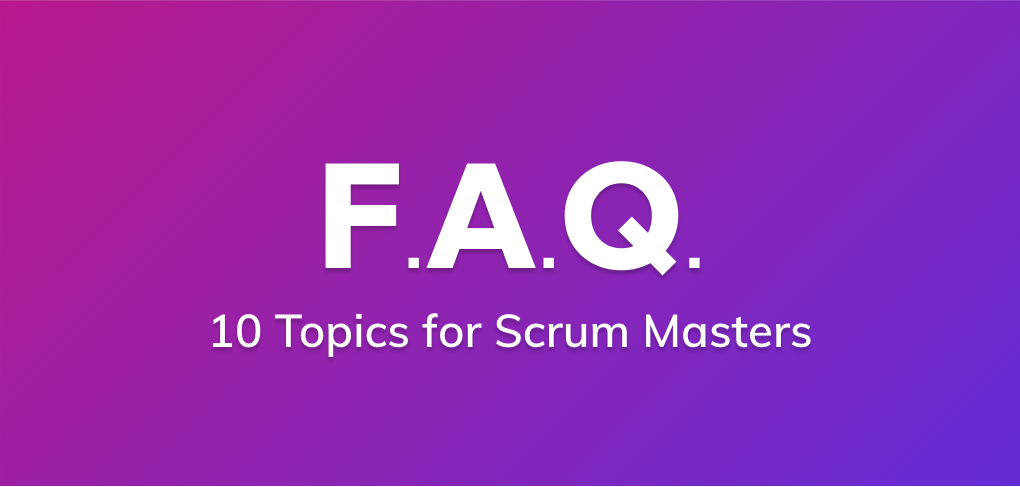
SCRUM Explained: 10 FAQs for SCRUM Masters

What are the responsibilities of a SCRUM Master? What are the tools a SCRUM Master uses? In this article we expand on these and other top questions around the SCRUM Master role.
Who is a SCRUM Master, and what is their role?
The SCRUM Master plays a crucial role in facilitating the adoption of Scrum and ensuring its effective implementation within an agile team. They are responsible for guiding and supporting the SCRUM team to ensure effective Scrum implementation and a successful project outcome.
10 Key Responsibilities of a SCRUM Master:
Facilitate SCRUM Adoption: Assist in the team's understanding and application of the Scrum framework.
Empower and Guide: Encourage self-organization and guide the team in decision-making.
Impediment Removal: Identify and remove obstacles that hinder the team's progress.
Coach and Mentor: Provide guidance and coaching on SCRUM practices and agile principles.
Facilitate Team Meetings: Ensure agile ceremonies, like Daily Standups and Retrospectives, are well-organized and productive.
Continuous Improvement: Foster a culture of continuous learning and process enhancement.
Conflict Resolution: Mediate and resolve conflicts within the team to maintain a positive work environment.
Stakeholder Communication: Facilitate effective communication and collaboration between the team and stakeholders.
Product Owner Support: Collaborate with the Product Owner to maintain a well-refined product backlog.
Transparency Advocacy: Ensure transparency in team activities through information radiating methods.
Overall, the SCRUM Master's role is to create an environment where the team can thrive, continually improve and deliver valuable, high-quality products. They act as a guide, facilitator, and mentor to ensure that SCRUM principles are understood and effectively applied, while also fostering a culture of collaboration, transparency, and agility within the team.
What knowledge should a SCRUM Master have?
A SCRUM Master should have a good understanding of the SCRUM framework and agile principles. They need to know how this specific agile methodology works, as well as the roles, ceremonies, and artifacts. They should also be aware of the values and principles in the Agile Manifesto.
In addition to the technical knowledge, a SCRUM Master should have good communication and problem-solving skills. They need to help their team work better, so being a good listener and communicator is vital.
It's also essential to have a positive attitude, patience, and empathy, as they'll be working closely with team members and stakeholders. Continuous learning is crucial because the agile landscape is constantly evolving.
What are the main tools for a SCRUM Master?
A SCRUM Master uses various tools to help their team implement the SCRUM framework for agile project management. Some main tools include:
Task Boards: Physical or digital boards are used to visualize and manage tasks, making it easier for the team to track work items throughout the sprint.
Retrospective Techniques: Methods like the "Plus-Delta" or "Start-Stop-Continue" to facilitate discussions and improvements in the team's processes.
Communication Tools: Platforms like Slack, Microsoft Teams, or even simple email for effective team communication.
Agile Project Management Software: Tools like Jira or Asana to manage and track the progress of tasks, user stories, and sprints.
Collaboration Tools: Tools like Miro or Microsoft Whiteboard for collaborative brainstorming and planning sessions.
These tools help the SCRUM team organize their work, monitor progress, and continuously improve their processes to deliver high-quality results in an agile and iterative manner.
What is the difference between an Agile Coach and a SCRUM Master?
The main difference between an Agile Coach and a SCRUM Master is their scope of responsibility. A SCRUM Master focuses on helping a specific team follow the SCRUM framework. At the same time, an Agile Coach works with multiple teams and the entire organization to promote Agile principles and practices, focusing on the broader picture of agility.
What are the main differences between Agile and SCRUM?
Aspect | Agile | SCRUM |
|---|---|---|
Framework | A broad methodology or mindset for delivering projects and products with flexibility and customer collaboration. | A specific framework within the Agile methodology, providing a structured approach to product development. |
Flexibility | Flexible and can incorporate various methods and practices, allowing teams to adapt to their specific needs. | Provides a defined set of roles, events, and artifacts, offering less flexibility compared to Agile as a whole. |
Roles | Doesn't prescribe specific roles but emphasizes collaboration and self-organizing teams. | Defines specific roles, including SCRUM Master, Product Owner, and Development Team. |
Artifacts | Doesn't have fixed artifacts, but it encourages creating relevant documentation as needed. | Defines artifacts like the Product Backlog, Sprint Backlog, and Increment. |
Time-Boxed Events | Doesn't prescribe time-boxed events but promotes regular collaboration and feedback. | Includes time-boxed events such as Sprint Planning, Daily Scrum, Sprint Review, and Sprint Retrospective. |
Prioritization | Prioritizes work based on customer feedback and changing requirements, focusing on delivering value. | Prioritizes work through the Product Backlog, with the Product Owner responsible for setting priorities. |
Iterative Development | Can use iterative development, but it's not mandatory. | Mandates iterative development in fixed time periods called Sprints. |
Scalability | Can be scaled using frameworks like SAFe, LeSS, or Disciplined Agile to manage larger and more complex projects. | Often used at the team level but can be scaled using frameworks like LeSS or Nexus for larger organizations. |
Remember that Agile is a broader approach, while SCRUM is a specific implementation of Agile principles. Many organizations combine elements of both to suit their needs.
What are the limitations of SCRUM?
SCRUM offers many benefits, such as improved team collaboration and faster delivery of working products. However, it also has some limitations.
One significant limitation is its rigidity. The fixed roles, events, and artifacts may only suit some project types or organizational cultures. SCRUM can be challenging to scale for larger projects or organizations, requiring additional frameworks like LeSS or SAFe.
Additionally, it may need to provide detailed guidance on certain technical practices, which could be a limitation for teams with a solid technical foundation. Furthermore, for SCRUM to be effective, it relies heavily on active participation and commitment from all team members, and this can be a challenge in some work environments.
Despite these limitations, many organizations have successfully adapted SCRUM to their needs while addressing its shortcomings.
How do you handle conflicts within a SCRUM team or between teams?
Conflicts can occur in any team, but SCRUM provides a framework for productively managing them. Here are some actionable tips for SCRUM Masters to effectively manage conflicts within their teams, promoting efficiency and collaboration:
Early Intervention: Address conflicts as soon as they arise. Encourage team members to discuss issues openly, ensuring they don't escalate.
Active Listening: Act as a mediator, actively listening to both sides of the conflict without taking sides. Ensure that team members feel heard and understood.
Transparency: Promote transparency in decision-making and problem-solving processes. Ensure that the team knows how conflicts are being resolved.
Retrospectives: Use regular retrospectives to create a safe space for the team to reflect on and address any ongoing conflicts, making it a part of continuous improvement.
Empower Self-Organization: Encourage the team to self-organize and resolve conflicts whenever possible, only intervening when necessary.
Coach and Mentor: Provide coaching and mentorship to team members on effective communication and conflict-resolution skills.
Set Clear Expectations: Define team norms and values to prevent conflicts related to roles, responsibilities, or working practices.
Collaborative Problem-Solving: Encourage the team to collaborate to find solutions everyone can agree on, fostering a sense of ownership and unity.
Follow the SCRUM Values: Emphasize Scrum values of commitment, courage, focus, openness, and respect, reminding team members to live by them in their interactions.
Seek External Help When Necessary: If conflicts persist or become detrimental to the team's performance, don't hesitate to involve external support or HR professionals.
By following these tips, SCRUM Masters can help create a harmonious and collaborative environment within their teams, ultimately enhancing efficiency and productivity.
What are the five most common challenges SCRUM Masters face, and how do you overcome them?
There are various challenges a SCRUM master may face, especially when it comes to remote teams. Here are a few of them and some tips on how you can overcome them to create a more productive SCRUM environment.
Resistance to Change: To tackle resistance from team members or stakeholders, communicate the benefits of Agile and Scrum. Provide training and mentorship to help everyone adapt to the new practices gradually.
Lack of Empowerment: Encourage team members to take ownership of their work and decisions. Empower them to self-organize, make choices, and resolve issues independently. This fosters a sense of responsibility and collaboration.
Overcoming Dysfunctional Behavior: Address disruptive behavior within the team promptly. Use coaching techniques to help team members understand the impact of their behavior on the group and promote a culture of respect and openness.
Scope Creep: Prevent scope creep by maintaining a well-defined and prioritized backlog. Work closely with the Product Owner to resist the introduction of unplanned work during a sprint. Stick to the commitments made during Sprint Planning.
Balancing Roles: As a Scrum Master, balancing responsibilities can be challenging. Prioritize your Scrum Master role and delegate non-essential tasks when possible. Collaboration with other Scrum Masters can also help manage the workload effectively.
How do you handle situations where a team member is consistently underperforming in a SCRUM team?
When dealing with a consistently underperforming team member in a SCRUM team, it's crucial to approach the situation with empathy and accountability.
Start by having a private, one-on-one conversation with the team member to understand their perspective and any challenges they might face. This can help identify potential root causes of underperformance. If it's a skills or knowledge gap, consider providing training or mentoring.
If the issue persists, involve the team in a retrospective to discuss the problem openly and find solutions collectively.
Sometimes, it may be necessary to escalate the matter to upper management or HR if the team member's underperformance continues to hinder the team's progress. The key is to maintain a balance between support and accountability, aiming to help the team members improve while ensuring the team's overall productivity and cohesion.
What are some best practices for managing a distributed SCRUM team effectively?
Effectively managing a distributed SCRUM team involves clear and frequent communication through video conferencing and digital tools. Asynchronous communication accommodates different time zones, while a shared "Definition of Done" ensures consistency.
Trust the team to self-organize and make local decisions, maintaining a strong team culture through occasional in-person or virtual meetings. Regularly review and adapt remote work practices to enhance productivity. These are a few of the best approaches to enable the benefits of a distributed SCRUM team while ensuring efficiency and collaboration.
Do you have more questions about SCRUM? Get in touch with us today!

More articles to check

Assist your team's growth with our partnership program:








